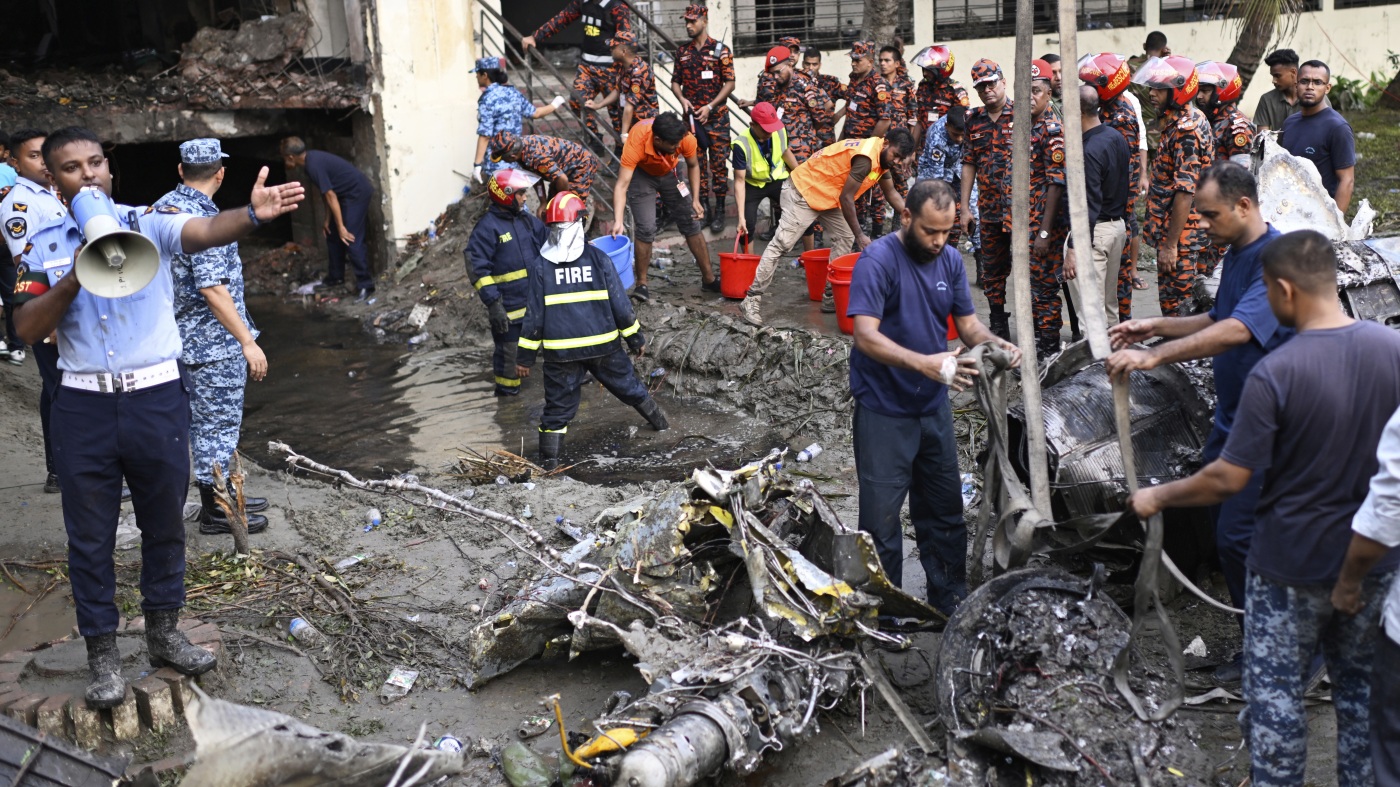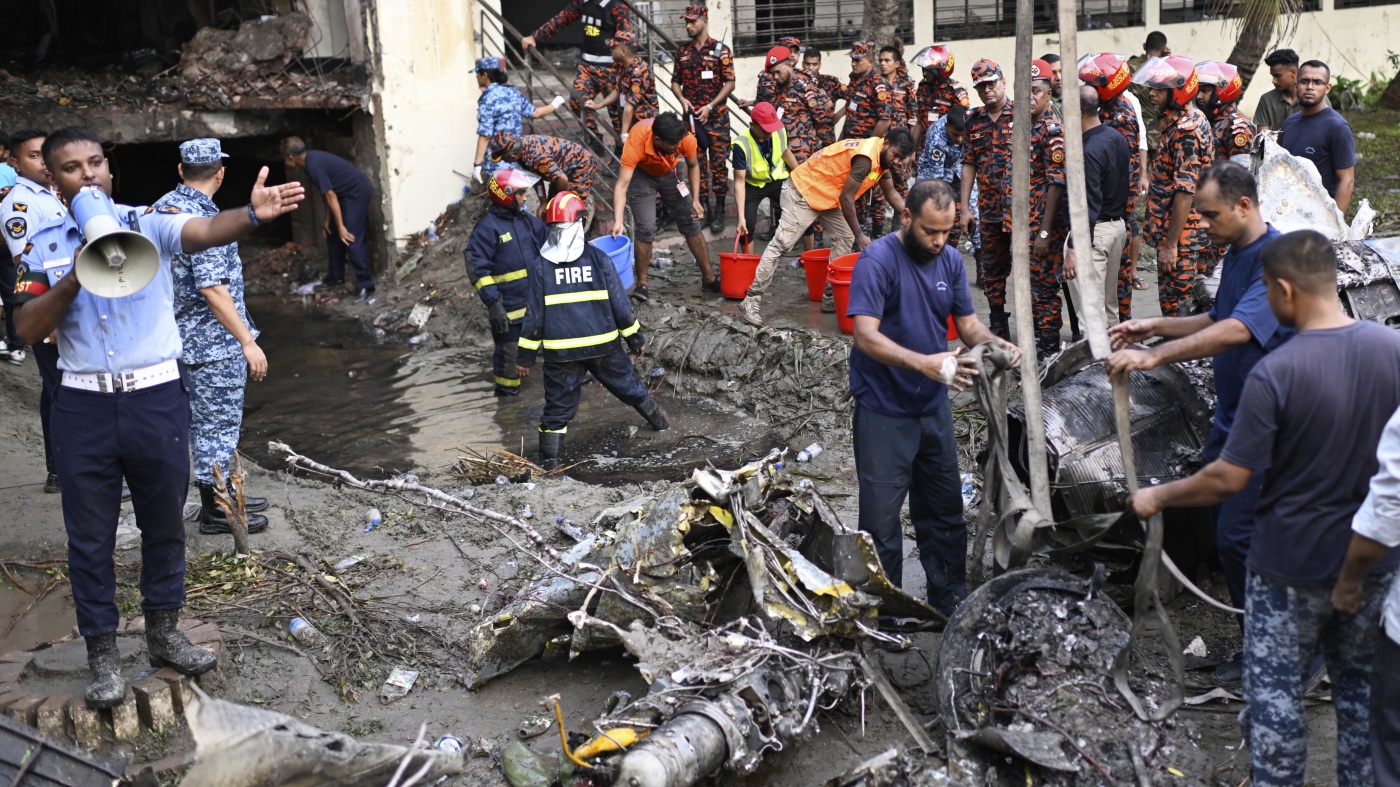The Dhaka Air Tragedy: A Comprehensive Analysis
Introduction
The skies over Dhaka, Bangladesh, were shattered by a devastating tragedy when a Bangladesh Air Force training jet crashed into a school campus. The incident, which occurred on a fateful Monday, claimed the lives of at least 19 people and left scores injured. The crash site, located at the Milestone School and College in Dhaka’s Uttara neighborhood, became a scene of unimaginable horror. This report delves into the details surrounding the crash, explores potential causes, and examines the broader implications for aviation safety and emergency response in Bangladesh.
A Scene of Chaos and Devastation
The crash site presented a scene of unimaginable horror. Eyewitness accounts describe a sudden, deafening roar followed by a violent explosion as the Chinese-made F-7 BGI aircraft plummeted onto the school grounds. The impact unleashed a torrent of debris, scattering wreckage across the campus and engulfing the area in flames.
Rescue efforts were immediately hampered by the sheer scale of the disaster. Firefighters and emergency responders struggled to navigate the wreckage-strewn landscape, battling flames and working tirelessly to extricate survivors from the debris. The injured, many with severe burns and trauma, were rushed to nearby hospitals, overwhelming the capacity of medical facilities and stretching resources to their limits.
Victims and Impact
The victims of the crash include students, faculty, and the pilot of the training jet. The loss of life, particularly among young students, has sparked widespread grief and outrage. Families are grappling with unimaginable loss, while the community mourns the collective tragedy.
Beyond the immediate loss of life, the crash has had a profound impact on the school and surrounding community. The Milestone School and College, once a place of learning and growth, is now a scene of devastation. The emotional scars of the tragedy will likely linger for years to come, affecting the mental health and well-being of students, faculty, and residents.
Investigating the Cause
While the exact cause of the crash remains under investigation, preliminary reports suggest a possible mechanical failure or pilot error. The F-7 BGI, a Chinese-made fighter jet, has been in service with the Bangladesh Air Force for several years. While considered a reliable aircraft, its age and maintenance history will undoubtedly be scrutinized as part of the investigation.
Technical Malfunction
A thorough examination of the wreckage will be crucial in determining whether a technical malfunction contributed to the crash. Investigators will analyze the aircraft’s engines, flight control systems, and other critical components for signs of failure or malfunction.
Pilot Error
Pilot error is another potential factor that will be carefully considered. Investigators will review the pilot’s training records, flight experience, and communications with air traffic control to assess whether any errors in judgment or execution may have contributed to the accident.
Weather Conditions
While weather conditions at the time of the crash were reported to be clear, investigators will review meteorological data to rule out any unforeseen weather-related factors that may have played a role.
Maintenance Records
A comprehensive review of the aircraft’s maintenance records will be conducted to identify any potential lapses in maintenance procedures or recurring mechanical issues that may have contributed to the crash.
Aviation Safety Concerns
The crash raises serious concerns about aviation safety standards in Bangladesh. While the country has made strides in improving air safety in recent years, this incident underscores the need for continued vigilance and investment in safety measures.
Training and Maintenance
The incident highlights the importance of rigorous training programs for pilots and maintenance personnel. Adequate funding and resources must be allocated to ensure that pilots are fully equipped to handle emergency situations and that maintenance personnel are properly trained to identify and address potential mechanical issues.
Aircraft Maintenance and Inspection
The age of the aircraft involved in the crash raises questions about the adequacy of maintenance and inspection procedures. Regular inspections and timely repairs are essential to ensure the continued airworthiness of aging aircraft.
Air Traffic Control
A review of air traffic control procedures and communication protocols is necessary to identify any areas for improvement. Clear and concise communication between pilots and air traffic controllers is critical for ensuring safe air navigation.
Emergency Response
The crash also exposed shortcomings in the country’s emergency response capabilities. Improved coordination between emergency responders, better access to specialized equipment, and enhanced training for rescue personnel are essential to improve the effectiveness of emergency response efforts.
A Call for Action
The tragic crash in Dhaka serves as a stark reminder of the risks associated with aviation and the importance of prioritizing safety at all levels. The government of Bangladesh must take immediate action to address the underlying issues that contributed to the crash and to prevent similar tragedies from occurring in the future.
Independent Investigation
A thorough and independent investigation into the crash is essential to determine the root cause and to identify any systemic failures that need to be addressed. The investigation should be conducted by a team of experts with no vested interests in the outcome.
Review of Safety Standards
A comprehensive review of aviation safety standards in Bangladesh is necessary to ensure that they meet international best practices. The review should cover all aspects of aviation safety, including pilot training, aircraft maintenance, air traffic control, and emergency response.
Investment in Infrastructure
Increased investment in aviation infrastructure, including modern air traffic control systems, upgraded airport facilities, and improved emergency response capabilities, is essential to enhance aviation safety.
Transparency and Accountability
The government must be transparent about the findings of the investigation and take swift action to hold those responsible for any negligence or wrongdoing accountable.
A Nation in Mourning
The Bangladesh Air Force training jet crash has left a nation in mourning. As the country grapples with the aftermath of this tragedy, it is imperative that lessons are learned and that concrete steps are taken to prevent similar incidents from occurring in the future. The lives lost in this senseless accident must not be in vain. The memory of those who perished should serve as a catalyst for change, prompting a renewed commitment to aviation safety and a more proactive approach to preventing future tragedies. The road to recovery will be long and arduous, but with determination and unwavering resolve, Bangladesh can emerge from this crisis stronger and more resilient.
Remembering the Fallen
The echoes of the crash will forever remain in the hearts of those who lost loved ones, and the nation must unite in offering support and solace to the grieving families. It is through remembering the fallen and honoring their memory that we can find the strength to move forward and build a safer future for all.








